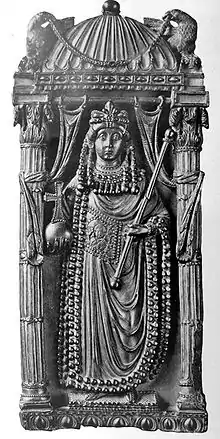515
Year 515 (DXV) was a common year starting on Thursday (link will display the full calendar) of the Julian calendar. At the time, it was known as the Year of the Consulship of Florentius and Anthemius (or, less frequently, year 1268 Ab urbe condita). The denomination 515 for this year has been used since the early medieval period, when the Anno Domini calendar era became the prevalent method in Europe for naming years.
| Millennium: | 1st millennium |
|---|---|
| Centuries: | |
| Decades: | |
| Years: |
| 515 by topic |
|---|
| Leaders |
|
| Categories |
|
| Gregorian calendar | 515 DXV |
| Ab urbe condita | 1268 |
| Assyrian calendar | 5265 |
| Balinese saka calendar | 436–437 |
| Bengali calendar | −78 |
| Berber calendar | 1465 |
| Buddhist calendar | 1059 |
| Burmese calendar | −123 |
| Byzantine calendar | 6023–6024 |
| Chinese calendar | 甲午年 (Wood Horse) 3211 or 3151 — to — 乙未年 (Wood Goat) 3212 or 3152 |
| Coptic calendar | 231–232 |
| Discordian calendar | 1681 |
| Ethiopian calendar | 507–508 |
| Hebrew calendar | 4275–4276 |
| Hindu calendars | |
| - Vikram Samvat | 571–572 |
| - Shaka Samvat | 436–437 |
| - Kali Yuga | 3615–3616 |
| Holocene calendar | 10515 |
| Iranian calendar | 107 BP – 106 BP |
| Islamic calendar | 110 BH – 109 BH |
| Javanese calendar | 402–403 |
| Julian calendar | 515 DXV |
| Korean calendar | 2848 |
| Minguo calendar | 1397 before ROC 民前1397年 |
| Nanakshahi calendar | −953 |
| Seleucid era | 826/827 AG |
| Thai solar calendar | 1057–1058 |
| Tibetan calendar | 阳木马年 (male Wood-Horse) 641 or 260 or −512 — to — 阴木羊年 (female Wood-Goat) 642 or 261 or −511 |

Empress Ariadne (c. 450–515)
Events
Byzantine Empire
- Autumn – Revolt of Vitalian: Byzantine general (magister militum) Vitalian mobilises his army, and marches again towards Constantinople. He captures the suburb of Sycae (modern Turkey) across the Golden Horn, and encamps there.
- Emperor Anastasius I gives Marinus, former praetorian prefect of the East, command over the Byzantine army.[1] He defeats the rebel fleet at the harbor entrance, using a sulfur-based chemical substance, similar to the later Greek fire.
- Marinus lands with an army on the shore of Sycae and defeats the rebels. Disheartened by the losses suffered, Vitalian flees north under cover of the night.[2]
- As a sign of his victory, Anastasius I leads a procession to Sosthenion, and attends a service of thanks at the local church dedicated to the Archangel Michael.[3]
- Empress Ariadne, wife of Emperor Anastasius I, dies at Constantinople and is buried in the Church of the Holy Apostles.
Europe
- Amalasuintha, daughter of king Theodoric the Great, marries Eutharic, an Ostrogoth noble of the old Amal line.
Religion
- The St. Maurice's Abbey (Switzerland) is founded by Sigismund of Burgundy. He sets up five groups of monks to whom he entrusts the liturgy of the praise of God.[4]
Births
Deaths
- Ariadne, Byzantine empress
- Euphemius, patriarch of Constantinople
- Gao Zhao, high official of Northern Wei
- Xuan Wu Di, emperor of Northern Wei (b. 483)
References
- Bury 1958a, p. 451
- Bury 1958a, p. 451-452; Cameron, Ward-Perkins & Whitby 2000, pp. 57, 294
- Bury 1958a, p. 452
- "Abbaye de Saint-Maurice - Accueil > Bienvenue > English". Archived from the original on February 13, 2012. Retrieved February 13, 2012.
- Bibliography
- Bury, John Bagnell (1958a) [1923]. History of the Later Roman Empire: From the Death of Theodosius I to the Death of Justinian, Volume 1. Mineola, New York: Dover Publications. ISBN 0-486-20398-0.
- Bury, John Bagnell (1958b) [1923]. History of the Later Roman Empire: From the Death of Theodosius I to the Death of Justinian, Volume 2. Mineola, New York: Dover Publications. ISBN 0-486-20399-9.
- Cameron, Averil; Ward-Perkins, Bryan; Whitby, Michael, eds. (2000). The Cambridge Ancient History, Volume XIV: Late Antiquity: Empire and Successors, A.D. 425–600. Cambridge: Cambridge University Press. ISBN 9780521325912.
This article is issued from Wikipedia. The text is licensed under Creative Commons - Attribution - Sharealike. Additional terms may apply for the media files.